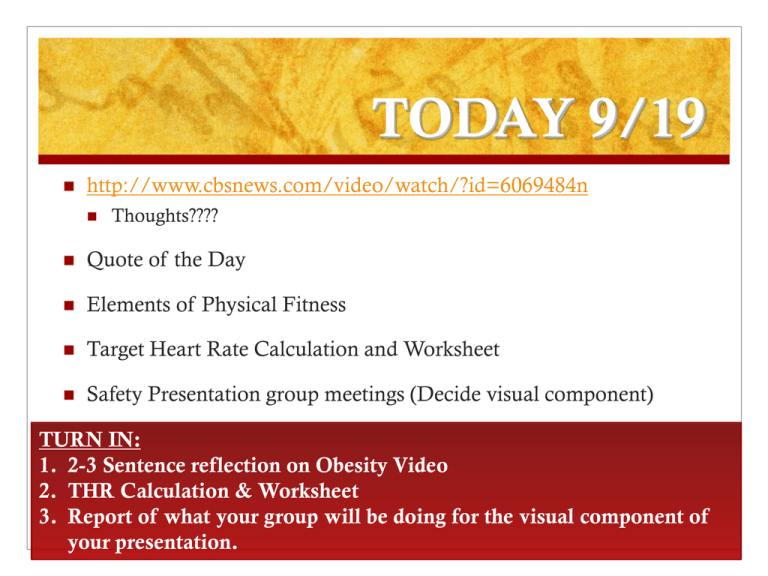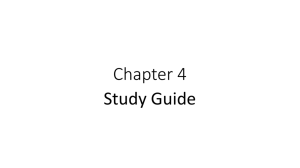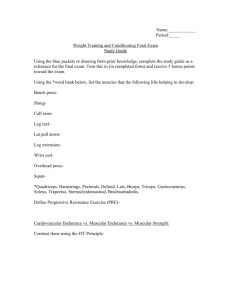Elements of Fitness - ilovePhysicalEducation
advertisement

TODAY 9/19 http://www.cbsnews.com/video/watch/?id=6069484n Thoughts???? Quote of the Day Elements of Physical Fitness Target Heart Rate Calculation and Worksheet Safety Presentation group meetings (Decide visual component) TURN IN: 1. 2-3 Sentence reflection on Obesity Video 2. THR Calculation & Worksheet 3. Report of what your group will be doing for the visual component of your presentation. Class Results: Elements of Fitness How would you describe what it means to be physically fit? http://www.wordle.net/create Elements of Fitness Health Related Fitness Skill Related Fitness Cardiorespiratory Endurance Agility Muscular Strength Balance Muscular Endurance Power Flexibility Speed Body Composition Coordination Reaction Time Categories of Fitness: Aerobic Exercise- Activity requires oxygen - Lower intensity, longer - Activities greater than 2 minutes - Ex. Walking or running for 20-30 min. Anaerobic Exercise- Activity does not require oxygen - High intensity, short duration - Up to 10 seconds of activity - Ex. Weight training, sprinting Resistance Exercise Isometric Exercise – Muscle tension improved muscle strength Little to no movement of body part ***Lets try a Straight Arm Plank*** Resistance Exercise Isotonic Exercise- Combines muscle contraction and extension Repeated movement Ex. push-ups, pull-ups, sit-ups ***Lets try 5 Push-ups*** Resistance Exercise Isokinetic Exercise- Resistance is moved through an entire range of motion (ROM) at a certain speed. The machine will then vary it's resistance against us to maintain that speed. Controlled speed Ex. Specialized Machine exercises Flexibility Ability to move a body part through a full range of motion (ROM) Poor Flexibility = Muscle Imbalances TYPES: Static – Passively holding muscle at point of tension for a minimum of 20 seconds. http://www.youtube.com/watch?v=l0uwEPzVsqk Dynamic – Use force and momentum to move joint through full ROM. http://www.youtube.com/watch?v=v1q4l1bkKY4&feature=related PNF (proprioceptive neuromuscular facilitation)- Potential for the most flexibility gains http://www.youtube.com/watch?v=4GWlJMSAlu4 Ballistic – Forced beyond normal range, bounce into position; not considered useful and can lead to injury.. http://www.youtube.com/watch?v=ep3Q1gzH8AQ Cardiovascular Fitness As heart rate increases, more oxygen is sent to muscles for energy Heart strengthened over time = more efficiency Increases lungs capacity to hold air AVERAGE RESTING HEART RATES AGE BEATS PER MINUTE (BPM) Infants – 1 year old 100 - 160 Children 1 – 10 years old 60 - 140 Children 10+, Adults 60 - 100 Athletes 40 - 60 Cardiovascular Fitness FITNESS TARGET HEART RATE ZONES Exercise Level Benefits Intensity (% of Max HR) Light Exercise Heart Maintenance 50% - 60% (Beginners, Older Adults) Weight Loss Burn Fat & Calories 60% - 70% Aerobic Increase Stamina & Endurance 70% - 80% Conditioning Fitness Conditioning, 80% - 90% Muscle Building, Athletic Training Athletic- Elite Athletic Training, Endurance 90% - 100% Agility: The ability to change and control the direction and position of the body while maintaining a constant, rapid motion. Ex. Changing directions to hit a tennis ball. Balance: The ability to control or stabilize the body when a person is standing still or moving. - Ex. Gymnasts Coordination The ability to use the senses together with body parts during movement. Ex. Dribbling a basketball, while moving forward. Speed: The ability to move your body or parts of your body swiftly. Ex. A tennis player moving forward to get to a drop shot. Reaction Time: The ability to reach or respond quickly to what you hear, see, or feel. Ex. an athlete quickly coming off the blocks early in a swimming or track relay. Power: The ability to move the body parts swiftly while applying the maximum force of the muscles. Combination of both speed and muscular strength. Ex. volleyball players jump to hit the ball







